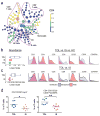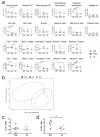Mass cytometry reveals a distinct immunoprofile of operational tolerance in pediatric liver transplantation
- PMID: 27781378
- PMCID: PMC5404744
- DOI: 10.1111/petr.12795
Mass cytometry reveals a distinct immunoprofile of operational tolerance in pediatric liver transplantation
Abstract
Long-term IS in transplant patients has significant morbidity, poorer quality of life, and substantial economic costs. TOL, defined as graft acceptance without functional impairment in the absence of IS, has been achieved in some pediatric LT recipients. Using mass cytometry, peripheral blood immunotyping was performed to characterize differences between tolerant patients and patients who are stable on single-agent IS. Single-cell mass cytometry was performed using blood samples from a single-center pediatric LT population of operationally tolerant patients to comprehensively characterize the immune cell populations in the tolerant state compared with patients on chronic low-dose IS. Specific T-cell populations of interest were confirmed by flow cytometry. This high-dimensional phenotypic analysis revealed distinct immunoprofiles between transplant populations as well as a CD4+ TOT (CD4+ CD5+ CD25+ CD38-/lo CD45RA) that correlates with tolerance in pediatric LT recipients. In TOL patients, the TOT was significantly increased as compared to patients stable on low levels of IS. This TOT cell was confirmed by flow cytometry and is distinct from classic Treg cells. These results demonstrate the power of mass cytometry to discover significant immune cell signatures that have diagnostic potential.
Keywords: T cells; cytometry by time of flight; immune cells; peripheral blood mononuclear cells; post-transplant.
© 2016 John Wiley & Sons A/S. Published by John Wiley & Sons Ltd.
Figures


Similar articles
-
Decreases in circulating CD4+CD25hiFOXP3+ cells and increases in intragraft FOXP3+ cells accompany allograft rejection in pediatric liver allograft recipients.Pediatr Transplant. 2009 Feb;13(1):70-80. doi: 10.1111/j.1399-3046.2008.00917.x. Epub 2008 Mar 10. Pediatr Transplant. 2009. PMID: 18331536
-
Evaluation of Immune Profiles and MicroRNA Expression Profiles in Peripheral Blood Mononuclear Cells of Long-Term Stable Liver Transplant Recipients and Recipients With Acute Rejection Episodes.Transplant Proc. 2015 Dec;47(10):2907-15. doi: 10.1016/j.transproceed.2015.10.048. Transplant Proc. 2015. PMID: 26707312
-
Evolution of CD4⁺CD25(hi) T cell subsets in Aspergillus-infected liver transplantation recipients reduces the incidence of transplantation rejection via upregulating the production of anti-inflammatory cytokines.Genet Mol Res. 2014 Jul 4;13(3):4932-9. doi: 10.4238/2014.July.4.7. Genet Mol Res. 2014. PMID: 25062480
-
[Development of immune tolerance in liver transplantation].Gastroenterol Hepatol. 2011 Mar;34(3):155-69. doi: 10.1016/j.gastrohep.2010.11.007. Epub 2011 Mar 3. Gastroenterol Hepatol. 2011. PMID: 21376423 Review. Spanish.
-
[Regulatory T cells and their influence in kidney allograft survival].Medicina (B Aires). 2007;67(5):491-501. Medicina (B Aires). 2007. PMID: 18051235 Review. Spanish.
Cited by
-
High-dimensional profiling of pediatric immune responses to solid organ transplantation.Cell Rep Med. 2023 Aug 15;4(8):101147. doi: 10.1016/j.xcrm.2023.101147. Epub 2023 Aug 7. Cell Rep Med. 2023. PMID: 37552988 Free PMC article.
-
Harnessing Mechanisms of Immune Tolerance to Improve Outcomes in Solid Organ Transplantation: A Review.Front Immunol. 2021 Jun 10;12:688460. doi: 10.3389/fimmu.2021.688460. eCollection 2021. Front Immunol. 2021. PMID: 34177941 Free PMC article. Review.
-
Prediction of tumor recurrence by distinct immunoprofiles in liver transplant patients based on mass cytometry.Am J Cancer Res. 2022 Sep 15;12(9):4160-4176. eCollection 2022. Am J Cancer Res. 2022. PMID: 36225628 Free PMC article.
-
Regulatory T cells in solid organ transplantation.Clin Transl Immunology. 2020 Feb 23;9(2):e01099. doi: 10.1002/cti2.1099. eCollection 2020. Clin Transl Immunology. 2020. PMID: 32104579 Free PMC article. Review.
-
Application of Mass Cytometry Platforms to Solid Organ Transplantation.Transplantation. 2024 Oct 1;108(10):2034-2044. doi: 10.1097/TP.0000000000004925. Epub 2024 Mar 12. Transplantation. 2024. PMID: 38467594 Review.
References
-
- ASFAR S, METRAKOS P, FRYER J, VERRAN D, GHENT C, GRANT D, et al. An analysis of late deaths after liver transplantation. Transplantation. 1996;61:1377–81. - PubMed
-
- GELSON W, HOARE M, DAWWAS MF, VOWLER S, GIBBS P, ALEXANDER G. The pattern of late mortality in liver transplant recipients in the United Kingdom. Transplantation. 2011;91:1240–4. - PubMed
-
- SCHONDER KS, MAZARIEGOS GV, WEBER RJ. Adverse Effects of Immunosuppression in Pediatric Solid Organ Transplantation. Pediatric Drugs. 2010;12:35–49. - PubMed
-
- RASMUSSEN A, DAVIES HF, JAMIESON NV, EVANS DB, CALNE RY. Combined transplantation of liver and kidney from the same donor protects the kidney from rejection and improves kidney graft survival. Transplantation. 1995;59:919–21. - PubMed
-
- KATZNELSON S, CECKA JM. The liver neither protects the kidney from rejection nor improves kidney graft survival after combined liver and kidney transplantation from the same donor. Transplantation. 1996;61:1403–5. - PubMed
MeSH terms
Grants and funding
LinkOut - more resources
Full Text Sources
Other Literature Sources
Medical
Research Materials

